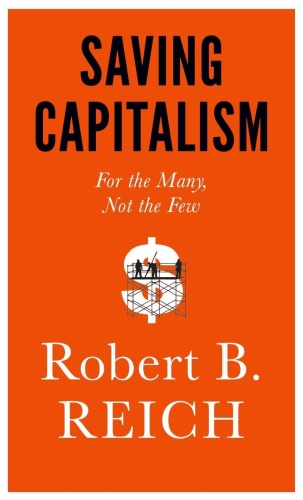

| SAVING CAPITALISM For the Many, Not the Few Robert B. Reich New York: Alfred A. Knopf, September 2015 |
Rating: 5.0 High |
|||
| ISBN-13 978-0-307-35057-0 | ||||
| ISBN-10 0-307-35057-0 | 279pp. | HC/GSI | $26.95 | |
After World War II, there was a business culture that recognized the rights of multiple stakeholders in corporations — including the "worker bees." Unions were strong, and prosperity was general. That began to change in 1973. Aided by favorable regulations, management acquired more and more power. The influence of labor unions waned, and in many cases once-traditional insurance and pension benefits disappeared. Executive salaries soared while worker compensation stagnated. Robert Reich has documented these changes in a number of books, including Supercapitalism.2
In this book, he explores the current situation of massive wealth and income inequality and tells us what might be done about it. His analysis ranges from the early days of the United States, when laws provided tax credits to encourage trawler captains to share the profits from the catch with their sailors, to the near future when automation will displace ever larger portions of a workforce already beleaguered by shrinking income and job prospects.
A crucial point is his dismantling of the artificial distinction between government and "the free market." The notion that there exists, or could exist, a free market that would distribute capitalism's rewards fairly to all participants if only government got out of the way is a total fiction.
"A market—any market—requires that government make and enforce the rules of the game. In most modern democracies, such rules emanate from legislatures, administrative agencies, and courts. Government doesn't "intrude" on the "free market." It creates the market. – Page 5 |
Reich devotes considerable space to this question of meritocracy throughout the book. On pages 92-93, he writes:
"If the rules governing how the market is organized took full account of the benefits to society of various roles and occupations, moreover, some epople would be paid far more. Social work, teaching, nursing, and caring for the elderly or for children are among the lowest-paid professions, yet evidence suggests that talented and dedicated people in these positions generate societal benefits far out of proportion to their pay. One such study found that good teachers increase the average present value of their students' lifetime income by $250,000 per classroom, for example. Presumably, if teaching jobs paid better they would attract many more such teachers." |
Indeed, to the extent that remuneration follows value to society, it generally follows the superficial sorts of value, such as popularity or ability to entertain. Thus the highest salaries go to professional atheletes, especially in baseball and football, and to a relative handful of actors and pop artists. The other group include those who chose rich parents or who were able to bend the rules in their favor, such as Wall Street managers.
Another persistent myth is the one that holds corporate America to be a meritocracy where what people are paid accurately measures their true value. Reich thoroughly demolishes this one by merely listing the levels of CEOs of major companies like IBM and Apple. Why do these fictions persist? Because they are useful smoke screens to hide the overweening influence of those who have gained the power to manipulate the system.
It is perhaps no accident that those who argue most vehemently on behalf of an immutable and rational "free market" and against government "intrustion" are often the same people who exert disproportionate influence over the market mechanism. They champion "free enterprise" and equate the "free market" with liberty while quietly altering the rules of the game to their own advantage. They extol freedom without acknowledging the growing imbalance of power in our society that's eroding the freedoms of most people. – Page 11 |
Then he tackles the myth that raising the minimum wage will either throw millions of people out of work or force employers to raise prices of their products so high they will be forced out of business. He debunks this one quite handily.
It is notable, for example, that in Denmark, where McDonald's workers over the age of eighteen earn the equivalent of twenty dollars an hour, Big Macs cost only thirty-five cents more than they do in the United States. – Page 137 |
Reich begins by explaining the five building blocks of capitalism. In his words (page 8), these are:
He then explains, in terms both particular and general, how the rules governing these building blocks have been distorted to favor the wealthy. For example, judges in other nations are typiucally appointed with the advice and consent of legislative bodies. In the U.S., 32 states hold elections for judges of state supreme courts, appelate courts, and trial courts. This makes it easy for a wealthy individual to finance the election of someone who will issue court rulings favorable to him.
Reich delivers a cogent analysis of the problem of inequality here, and the answers he proposes have merit. Any measures attempting to resurrect the sort of countervailing power once represented by labor unions — or even the restrictions once imposed by Glass-Steagal and other laws restraining abuses on the part of CEOs and Wall Street — faces a formidable challenge from the entrenched big-money interests. But the alternative is worse, for the sort of top-heavy capitalism currently holds sway in the land will sooner or later capsize American democracy.
I give this book top marks and judge it a keeper. It will soon be part of my library.

 To contact Chris Winter, send email to this address.
To contact Chris Winter, send email to this address.